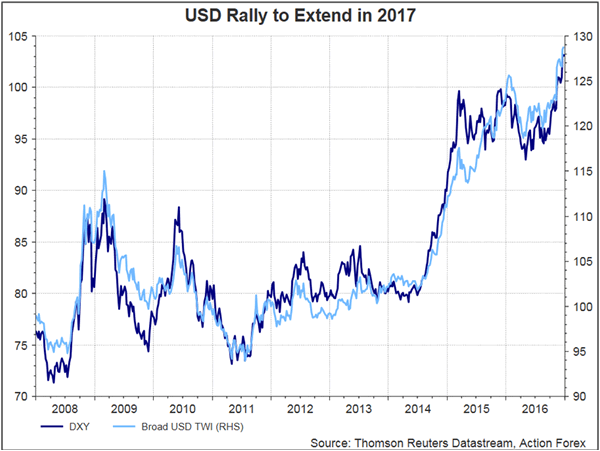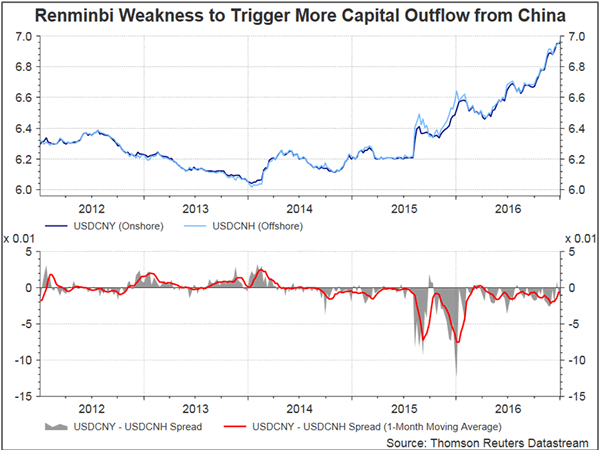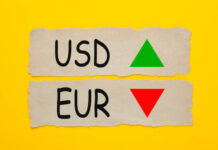2017 is year of high uncertainty, mainly hinging on the shift of global political agendas, from the new policy direction under Trump’s administration, to the beginning of negotiations between the UK and the EU on Brexit, to the leadership transition in China. On the currency outlook, we remain constructive over USD this year, anticipating Trump’s pro-growth policy would drive higher economic expansion and inflation, and facilitate a tighter monetary policy stance. With the market shy of pricing in three Fed funds rate hikes (as signaled in the December dot plot) this year, there is room for USD to rally further should incoming macroeconomic data eventually convince traders that more rate hikes are possible. We are bearish on Treasuries and expect US yields to move higher, especially at the front-end. Monetary policy divergence should bold well for the greenback, especially against the euro.
US pro-growth policy: Donald Trump promises to adopt expansionary fiscal policy with reduction in both income and corporate tax rates. A corporate tax rate at 15% (proposed by Trump, compared to House GOP’s 20%) could boost S&P 500 EPS by up to about 10% in 2017. Lower income tax rate, weighted towards higher-income groups, would be a boost to consumer spending. Trump’s ‘America’s Infrastructure First’ policy is supportive of ‘investments in transportation, clean water, a modern and reliable electricity grid, telecommunications, security infrastructure and other pressing domestic infrastructure needs’. While there is not yet a firm number on infrastructural expenditure, it is widely estimated that US$ 500B would be spent over a decade. The reforms, probably to be passed in the second half of the year, should result in above-trend economic growth and inflation. The downside risk, however, is that the new government fails to implement fiscal stimulus measures to an extent that is sufficient to boost growth that meets expectations. Other risks are that Trump’s actual policies, including those on immigration and Obamacare, turn out to be milder than what were promised in his election platform.

Policy Divergence and USD as High Yield Currency: The current Fed funds rate, at 0.75%, has made the greenback one of the top three G10 high yield currencies, after New Zealand dollar (RBNZ’s OCR at 1.75%) and Australian dollar (RBA’s cash rate at 1.5%). Capital inflows to the US should accelerate further given the likelihood that more rate hikes are coming this year, together with steady monetary policies in the antipodean central banks, capital inflation. Policy divergence is again a major theme this year. The December dot plot unveiled the median projection of 3 rate hikes this year, while the market has for now priced in only two, of which one would come in June. We believe the market would expect more rate hikes if the new government delivers the pro-growth policies as promised and if the US economic growth remains resilient. Nonetheless, expectations of two rate hikes, together with the upbeat growth profile, have already distinguished the Fed’s monetary policy from other major central banks’. For instance, ECB in December surprised the market by announcing tapering to its QE program, noting it would extend the program until December 2017 but would reduce the pace of buying to 60B euro per month from April 2017, compared with the current 80B euro. Yet, the central bank maintained a dovish tone in the accompanying statement, warning of "subdued underlying inflationary pressures" and ‘downside risks’ to growth. President Draghi also stressed that there’s no intention to taper to program towards zero and left the door open to increasing purchases again if necessary. Another example is BOC. While the central bank would likely keeps its monetary policy on hold throughout the year, the risk is for further easing. Meanwhile, the central bank would maintain a dovish tone in its monetary statements
Japanese yen would remain pressured against US dollar if BOJ sticks to its yield curve targeting policy. A more hawkish Fed and US-led yield curve steepening is likely to support USD against major currencies through widening yield differentials.


EM Currencies Worse Off
More rapid Fed funds rate hikes, Trump’s protectionism in the form of trade restrictions and global anti-immigration sentiment are likely to hammer emerging market economies. The first two events are expected to affect aversely EM currencies with large current account deficits. Higher US interest rates (both real and nominal) and a stronger greenback would tighten EM financial conditions. The market is concerned about the sharp depreciation in the Chinese renminbi, the official currency the world’s biggest economic growth driver. We expect the strong USD setting would continue renminbi’s depreciation and exacerbate capital outflow in China, leading to further intervention, such as widening of trading bands and capital controls, by PBOC













